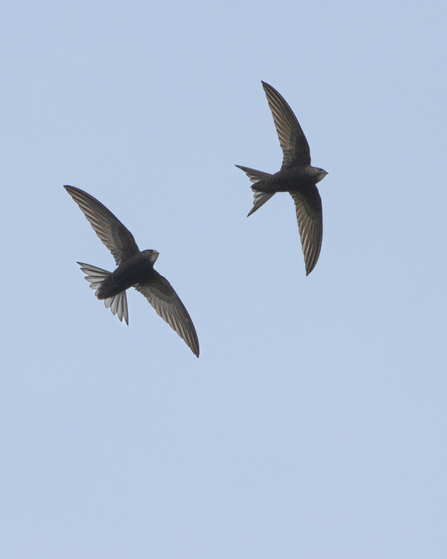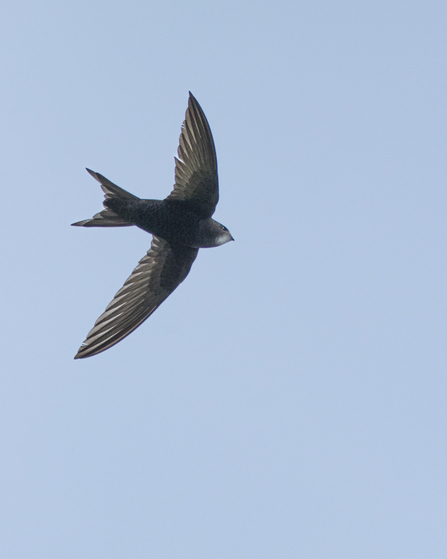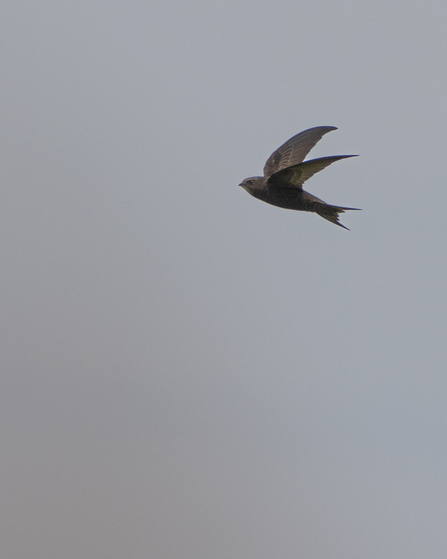Picture this: It’s a warm summer evening, you’re lying out in the park under a cloudless, bright blue sky with a belly full of picnic and above you, a sudden high-pitched, shrill screaming. A flock of dark, long winged, boomerang-shaped birds shoot across the sky in a pack, screeching in delight as they go: swifts!
Appreciating nature’s amazing aerial acrobat – the swift!
Swift ©David Tipling/2020VISION

Two swifts (C) George Cook
Swifts are my absolute favourite bird, and from 2 – 10 July it’s officially Swift Awareness Week! They slice through the sky with such ease and apparent enjoyment it is hard not to stop and watch them, imagining the sheer joy of being able to fly like that. Reaching speeds of almost 70mph, they have the record for the fastest bird in level flight. Their latin name, ‘Apus apus’ translates as ‘no foot’ as these birds rarely ever use their feet and basically live their entire lives in the sky only ever stopping to nest. For months at a time they will be in continuous flight, hunting, sleeping and even mating whilst flying!
Weighing the same as a Cadbury’s crème egg, these birds travel thousands of miles to the UK each year for the summer from Africa. That same bird that is screaming and catching insects over Ashton Court would have been soaring over the Sahara desert and Congo rainforest just a few weeks ago. Arriving in May, they only hang around long enough to lay their eggs and raise their chicks before they head back off on their long journey back to Africa in August. Hearing that first scream for me is always an exciting moment, as swifts mean summer! Their brief stay with us also makes me appreciate them more, watching them slice above me I am often filled with gratitude for their presence in the warm summer months, and yet slightly melancholy knowing that in just a few short weeks they will leaving again.

A swift flying (C) George Cook
Other than listening out for their scream there are other things to help you identify swifts. Firstly, they have long scythe-shaped wings which makes them look like boomerangs in the sky. Unlike similar birds like swallows or house martins, swifts are all brown so won’t have any patches of white on them. And remember, swifts only land in their nests, so if you see a bird sat on a telephone wire it is definitely not a swift!
Unfortunately these amazing aerial acrobats have recently been added to the red list. Bristol’s population of swifts has collapsed by 96% in just 20 years between 1994 and 2014. Swifts like to nest high up in gaps and crevices, which are becoming much rarer in new builds and refurbished buildings. The dramatic decline in insects is also likely to be negatively impacting them as these birds feed on flying insects such as aphids, mosquitos and beetles, sometimes referred to as aerial plankton.

(C) George Cook
We can all do something to protect these magic creatures by putting swift boxes up on our homes, schools and offices to provide them somewhere safe to nest. What a wonderful thing to enjoy welcoming back your swifts each summer! You can also help in surveying swifts by reporting your sightings on the Swift Mapper app.
Enjoy watching these screaming wonders while you can, as in a couple months they will be setting back to Africa on their next adventure!

